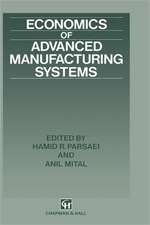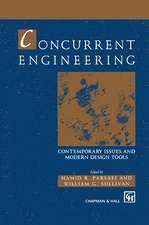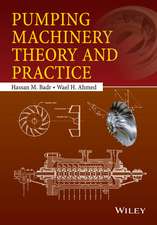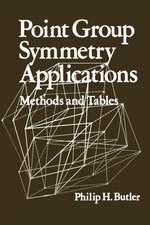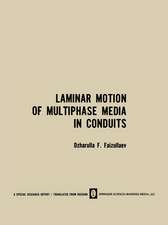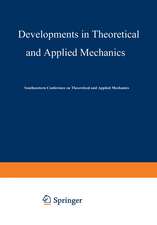Manufacturing Decision Support Systems: Manufacturing Systems Engineering Series, cartea 1
Editat de Hamid R. Parsaei, Thomas R. Hanley, S.S. Kollien Limba Engleză Paperback – 17 sep 2011
| Toate formatele și edițiile | Preț | Express |
|---|---|---|
| Paperback (1) | 945.92 lei 6-8 săpt. | |
| Springer Us – 17 sep 2011 | 945.92 lei 6-8 săpt. | |
| Hardback (1) | 948.92 lei 6-8 săpt. | |
| Springer Us – 31 dec 1996 | 948.92 lei 6-8 săpt. |
Preț: 945.92 lei
Preț vechi: 1153.57 lei
-18% Nou
Puncte Express: 1419
Preț estimativ în valută:
181.00€ • 189.46$ • 150.65£
181.00€ • 189.46$ • 150.65£
Carte tipărită la comandă
Livrare economică 31 martie-14 aprilie
Preluare comenzi: 021 569.72.76
Specificații
ISBN-13: 9781461285052
ISBN-10: 1461285054
Pagini: 328
Ilustrații: XXII, 302 p.
Dimensiuni: 155 x 235 x 17 mm
Greutate: 0.46 kg
Ediția:1997
Editura: Springer Us
Colecția Springer
Seria Manufacturing Systems Engineering Series
Locul publicării:New York, NY, United States
ISBN-10: 1461285054
Pagini: 328
Ilustrații: XXII, 302 p.
Dimensiuni: 155 x 235 x 17 mm
Greutate: 0.46 kg
Ediția:1997
Editura: Springer Us
Colecția Springer
Seria Manufacturing Systems Engineering Series
Locul publicării:New York, NY, United States
Public țintă
ResearchCuprins
1. A generalized cost analysis system for manufacturing simulation.- 1.1 Introduction.- 1.2 Review of past work.- 1.3 Design of the cost analysis system.- 1.4 System development and implementation.- 1.5 System validation.- 1.6 Conclusions and recommendations.- Acknowledgements.- References.- 2. A decision support system for the justification of computer-integrated manufacturing.- 2.1 Introduction.- 2.2 A DSS for CIM justification.- 2.3 DSS description.- 2.4 Activity-based costing.- 2.5 CIM and the firm’s profit and loss statement.- 2.6 Optimization models in CIM justification.- 2.7 The simulation model.- 2.8 The decision support system.- 2.9 Discussion and further research.- References.- 3. Linking strategies to actions: integrated performance measurement systems for competitive advantage.- 3.1 Introduction.- 3.2 Linking strategies to actions.- 3.3 Integrating performance measurement systems.- 3.4 Manufacturing decision support systems.- 3.5 Case example: the Hill’s® Pet Products Division of the Colgate-Palmolive Company.- 3.6 Conclusions.- References.- 4. Intelligent decision support for quality function deployment.- 4.1 Introduction.- 4.2 Active versus passive quality.- 4.3 Quality function deployment support system.- 4.4 Conclusion.- References.- 5. A knowledge-based decision support system for apparel enterprise evaluation.- 5.1 Introduction.- 5.2 Project objective.- 5.3 Current procurement and source selection procedures.- 5.4 Apparel manufacturing and quality control.- 5.5 Knowledge acquisition.- 5.6 Choice selection methodologies and selection of the inference mechanism for the decision support system.- 5.7 Design of the knowledge framework.- 5.8 The knowledge framework.- 5.9 Software implementation of decision support tool.- 5.10 User interface for BEST.-5.11 BESTForms implementation.- 5.12 BEST results.- 5.13 Conclusions.- Acknowledgements.- References.- 6. Heuristic decision support system database structure for diagnostic expert systems.- 6.1 Introduction.- 6.2 Handling uncertainty in diagnostic systems.- 6.3 Dempster-Shafer theory.- 6.4 Fuzzy logic.- 6.5 Problem-cause relationships.- 6.6 Design of the matrix structure.- 6.7 Example of the matrix.- 6.8 Database requirements for the matrix.- 6.9 Generating the knowledge base.- 6.10 Conclusions and recommendations.- References.- 7. Object-oriented organization of network flow problem-solving knowledge for manufacturing decision support systems.- 71 Introduction.- 7.2 Applications in manufacturing decision support systems.- 7.3 Object-oriented paradigm.- 7.4 Network flow problems.- 7.5 The object-based problem-solving knowledge for network flow problems.- 7.6 Implementation and observations.- 7.7 Conclusions.- Acknowledgements.- References.- 8. Machine learning for process parameter selection in intelligent machining.- 8.1 Introduction.- 8.2 Machine learning technique.- 8.3 Data acquisition.- 8.4 Results.- 8.5 Conclusions.- References.- 9. An interactive program for machine grouping and layout.- 9.1 Introduction.- 9.2 Literature review.- 9.3 Solution method.- 9.4 Interactive decision support system.- 9.5 Conclusions.- Acknowledgements.- References.- 10. Intelligent scheduling systems: an artificial-intelligence-based approach.- 10.1 Introduction.- 10.2 Issues involved in scheduling.- 10.3 An overview of genetic algorithms.- 10.4 Simulation design.- 10.5 Experiments.- 10.6 Conclusions.- Acknowledgements.- References.- 11. Optimizing assembly time for printed circuit board assembly.- 11.1 Introduction.- 11.2 Notations and problem statement.- 11.3 Optimization using integer programming.- 11.4 Simulation results.- 11.5 Conclusion.- Acknowledgements.- References.- 12. On integration of statistical process control and engineering process control: a neural network application.- 12.1 Introduction.- 12.2 Preliminaries.- 12.3 Simulation experiments.- 12.4 Conclusions.- Acknowledgements.- References.- 13. Constraint-based genetic algorithms for concurrent engineering.- 13.1 Introduction.- 13.2 Approaches to concurrent engineering systems.- 13.3 Research areas in concurrent engineering systems.- 13.4 Constraint network modeling and genetic algorithms.- 13.5 Overview of the CBGA concurrent engineering system.- 13.6 A CBGA design session.- 13.7 Summary and conclusion.- Acknowledgements.- References.- 14. Computer-integrated manufacturing: a complex information system.- 14.1 Introduction.- 14.2 Overview of programmable technologies used in computer-integrated manufacturing.- 14.3 A conceptualized information system for computer-integrated manufacturing.- 14.4 Toward the challenge of a computer-integrated economy.- 14.5 Conclusions.- References.








